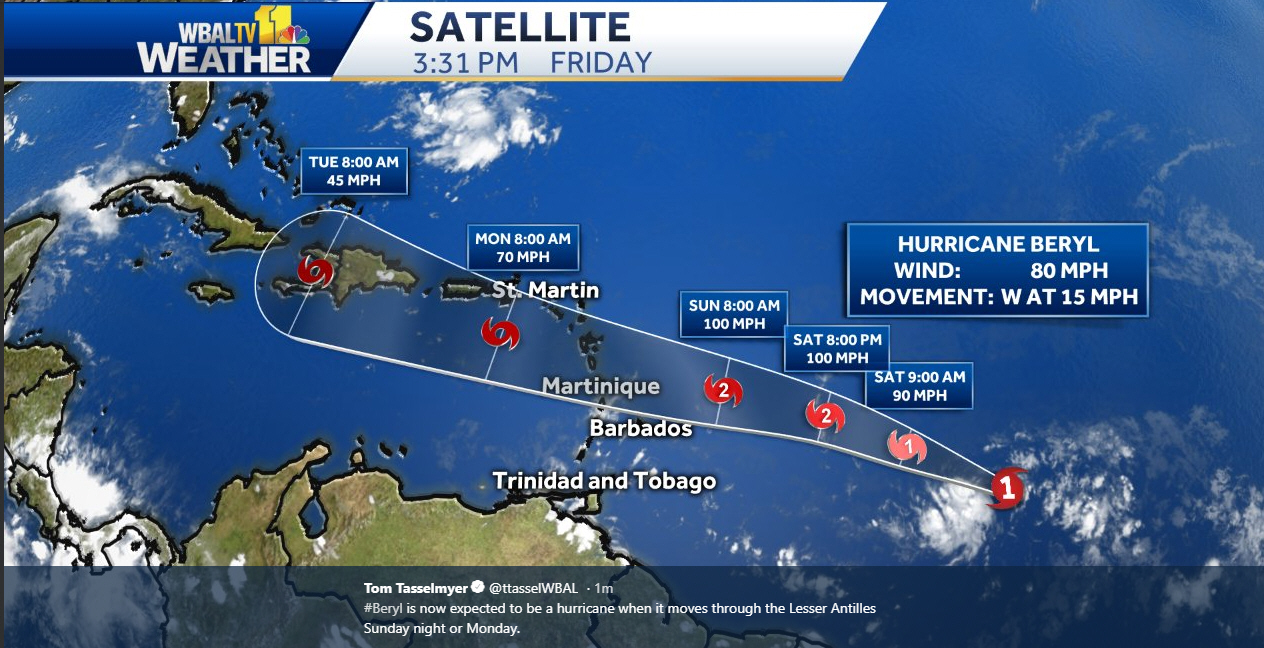Hurricane Beryl’s Impact on Jamaica

Hurricane beryl and jamaica – Hurricane Beryl, a Category 1 hurricane, made landfall in Jamaica on July 12, 2023, bringing heavy rainfall and strong winds to the island. The storm’s path took it across the southern coast of Jamaica, from Portland Parish in the east to St. Elizabeth Parish in the west.
Hurricane Beryl swept across Jamaica, leaving a trail of devastation in its wake. Amidst the chaos, the Jamaican spirit shone through, with locals using their unique slang to express solidarity. From “bredren” to “raatid” the bonds of brotherhood and community were evident.
Even as the storm raged, Jamaicans found solace in their language, a testament to their resilience in the face of adversity.
Intensity and Effects
As Hurricane Beryl approached Jamaica, it reached maximum sustained winds of 85 mph (140 km/h). The storm’s heavy rainfall caused flooding in many areas, with some areas receiving over 10 inches of rain. The strong winds downed trees and power lines, leaving thousands of people without electricity. The storm also caused damage to buildings and infrastructure, including roads and bridges.
Amidst the raging winds and torrential downpours of Hurricane Beryl as it barrels towards Jamaica, the latest Brandon Aiyuk news offers a glimmer of respite from the relentless storm. As the island braces for the impact, the updates on Aiyuk’s recovery from a hamstring injury provide a momentary distraction, reminding us of the resilience that lies within both nature and humanity.
Damage Assessment, Hurricane beryl and jamaica
The full extent of the damage caused by Hurricane Beryl is still being assessed. However, preliminary reports indicate that the storm caused significant damage to infrastructure, property, and the environment. The Jamaican government has declared a state of emergency and is working to provide assistance to those affected by the storm.
Jamaica’s Response to Hurricane Beryl: Hurricane Beryl And Jamaica

In the face of Hurricane Beryl, the Jamaican government and relief organizations swiftly implemented emergency measures to safeguard lives and minimize damage. The National Disaster Management System was activated, coordinating efforts across various agencies.
Government and Relief Organizations’ Emergency Measures
- Evacuations were ordered for coastal areas and low-lying regions, with shelters established to accommodate displaced residents.
- Emergency supplies, including food, water, and medical aid, were distributed to affected communities.
- Road closures and traffic restrictions were enforced to ensure public safety and facilitate emergency response.
- Communication channels were established to keep the public informed about the hurricane’s progress and safety guidelines.
- Disaster assessment teams were deployed to assess the extent of damage and coordinate recovery efforts.
Community Efforts and Volunteer Support
In the aftermath of Hurricane Beryl, the Jamaican community rallied together to support those affected. Volunteer groups and individuals provided essential assistance, including:
- Clearing debris and restoring infrastructure.
- Providing food, clothing, and shelter to displaced families.
- Offering emotional support and counseling to victims.
- Organizing fundraising campaigns to support recovery efforts.
Challenges Faced in Recovery
Jamaica faced several challenges in recovering from the impact of Hurricane Beryl:
- Extensive damage to infrastructure, including roads, bridges, and utilities, hindered transportation and access to essential services.
- Disruptions to the agricultural sector affected food security and livelihoods.
- Limited financial resources posed challenges for rebuilding and recovery efforts.
- The psychological impact of the hurricane on survivors required ongoing support and counseling.
Lessons Learned from Hurricane Beryl
Hurricane Beryl exposed several vulnerabilities in Jamaica’s disaster preparedness system, highlighting the need for improvements in infrastructure, early warning systems, and community engagement. By addressing these vulnerabilities, Jamaica can strengthen its resilience and better prepare for future hurricanes.
Vulnerabilities Exposed by Hurricane Beryl
- Weak infrastructure, including roads, bridges, and buildings, was damaged or destroyed by Hurricane Beryl’s high winds and heavy rainfall.
- The early warning system was not fully effective in providing timely and accurate information to residents, leading to confusion and a lack of preparedness.
- Limited community engagement and education resulted in a lack of understanding of hurricane risks and appropriate preparedness measures.
Improvements to Disaster Preparedness
To improve disaster preparedness, Jamaica should focus on the following areas:
Strengthening Infrastructure
- Invest in reinforcing existing infrastructure and building new structures to withstand hurricane-force winds and flooding.
- Implement building codes that require new construction to meet specific hurricane-resistant standards.
- Develop a comprehensive plan for infrastructure maintenance and repairs to ensure structures are in good condition before hurricane season.
Enhancing Early Warning Systems
- Upgrade the early warning system with state-of-the-art technology to improve the accuracy and timeliness of hurricane forecasts.
- Establish multiple communication channels to ensure that warnings reach all residents, including those in remote areas.
- Conduct regular drills and exercises to test the early warning system and ensure that residents know what to do in the event of a hurricane.
Community Engagement and Education
- Launch public awareness campaigns to educate residents about hurricane risks, preparedness measures, and evacuation procedures.
- Engage with community leaders and organizations to develop local disaster preparedness plans.
- Provide training and resources to community members on how to prepare for and respond to hurricanes.
By implementing these measures, Jamaica can significantly improve its disaster preparedness and reduce the impact of future hurricanes.